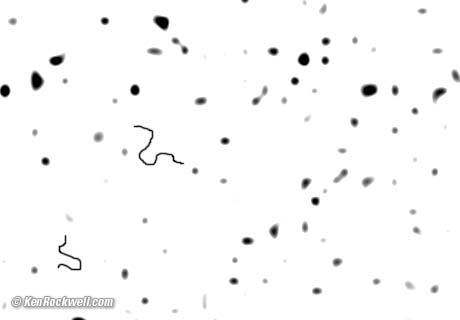Home Search Gallery How-To Books Links Workshops About Contact
|
Sensor Dirt, 2007
No longer seen as of 2007. I get my goodies at Ritz, Amazon and Adorama. It helps me publish this site when you get yours from those links, too. May 2007 INTRODUCTION Dirt was a huge problem when DSLRs were introduced in 1999. Thank goodness camera makers are now aware of the problem, and sensor dirt is no longer a problem with modern DSLRs. (Modern means introduced in the past 12 months or so.) l played with my first Nikon D1X in 2001. In the first few minutes of playing with it, I was able to see dirt in the images, weird for anything coming from Japan. We called Nikon, who thought something awful must have happened, and they sent us a replacement. It had the same problem, of course! How to Test for and See Dirt Set your camera to A (aperture-priority) exposure mode, select f/22, set your exposure compensation to +1 stop, point the camera at the sky or an out-of-focus blank wall, and shoot. Look at the photo. You'll see any dirt that's going to be visible. You can look at the image on the large screen of your computer, and you also can see it on your camera's zoomed-in LCD. Since this is a worst-case test, you'll see everything. Actual photos made at reasonable apertures won't show anywhere near as much, and usually won't show any. Funnier still are people who want to sell you special devices to see dirt. If dirt wasn't visible without a scope, it wouldn't be a problem, duh! You look for dirt in your images, not by looking at your sensor. If you were silly enough to use these things, you potentially make any problems worse by removing lenses and poking these devices into your camera. What Makes Dirt Visible Dirt is visible on blank areas like the sky. It blends into busy areas like a tree. Dirt is seen as shadows cast by dirt onto the sensor. Dirt lies not exactly on the sensor, but on a filter a little bit in front of the sensor. Therefore dirt is most visible at small apertures, which cast sharper shadows onto the sensor. Dirt is most visible at f/22, much less visible at f/8, and goes away at f/1.4. If you are shooting and see a dirt problem, open up a few stops and it will go away until you can clean your sensor. How Camera Makers Solved the Dirt Problem Easy: Camera makers learned to increase the spacing between the protective filters and the sensor itself. What looks like the sensor is actually a sandwich with several components, with the sensor at the bottom. By moving the anti-alias and infra-red cut filters further away from the actual sensor, they throw any dirt further out of focus so it no longer is a problem. Some makers also add devices to jiggle the sensor to dislodge dirt. Back in 2001 camera designers worked in special clean rooms, and didn't ask themselves what happened when sensors inevitably got dirty. They made very thin sandwiches of the sensors and filters, and you could see all the dirt even at moderate apertures. I had problems on my D1H. My D40, D70, D80, D200 and Canon 5D and Rebel XTi are fine. How to Avoid Dirt Avoid small apertures. I never shoot smaller than f/11 on digital, because dirt is emphasized and sharpness is lost due to diffraction. I avoid changing lenses, but when I'm out doing lens tests and comparisons for you people I change lenses a lot, like five times in five minutes! If anyone is going to have a dirt problem, it's me. I rarely have to blow dirt off my sensors. Dirt's not an issue any more. How to Fix Dirt In Photoshop, I use the Spot Healing Brush tool. I cases where the Spot Healing Brush can't find a correct texture to replicate, the Clone Tool works better, but takes more time. Cleaning Camera Sensors I've never, ever touched a sensor! See cleaning camera sensors. I spent $5 on a blower bulb (not brush) and it's all I've ever needed these past 5 years to keep all my cameras clean. Circus-style hucksters love to sell people things they don't need. All because dealers offer high-profit cleaning kits doesn't mean you should buy them. I know a photographer who completely destroyed her new D2X by wiping it carefully with a swab that accidentally had picked up a microscopic bit of dirt. Final Recommendations Don't worry. Get a blower bulb, don't stop down more than f/11, read Cleaning Camera Sensors, and go make some great photos!PLUG If this just saved you cash or if you found this as helpful as a book you might have had to buy or a workshop you may have had to take, feel free to help me continue helping everyone. Thanks for reading! Ken
Caveat: The ads below come from a third party and I don't see or approve them. They are sent to your screen directly from a third party. They don't come from me or my site. See more at my Buying Advice page. Personally I get my goodies at Ritz, Amazon and Adorama. |
Home Search Gallery How-To Books Links Workshops About Contact




